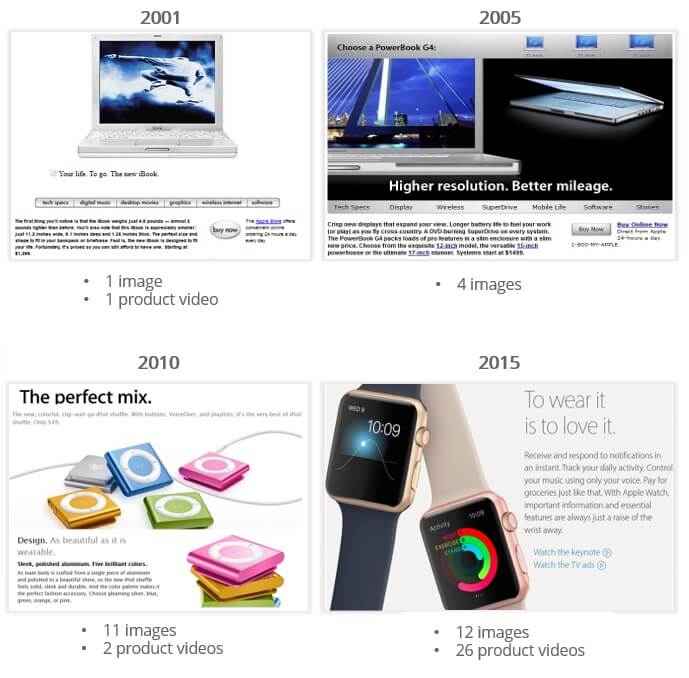Ecommerce Post-COVID-19: 5 Things You Need to Do to Prepare
by Daryl Klingaman • May 4, 2020
The following is an op-ed piece. 🙂
I’ve been asked the following question countless times over the past several weeks: “What does ‘normal’ look like after this?”, speaking of the world post-COVID19.
My answer typically falls along the lines of “there is no more ‘normal’”.
To explain, let’s start by talking about ecommerce, how it’s changed over the years and how those changes have affected online shopping expectations.
Buyer Expectations are Constantly Evolving
Think of the ecommerce world in 2005. What did it look like? Terrible product images, no point of reference for size (maybe an antiquated size chart at best), paying $5 for shipping on a $20 clothing item, only to receive it and realize it doesn’t fit, and paying $5 to return it.

Image Source: Sailthru.
That was our status quo and we knew no better.
Along came Zappo’s free shipping AND free returns. Then Amazon began offering two-day shipping. And then free returns. The ecommerce world was changed forever.
Ecommerce companies were forced to adopt similar tactics, policies and guarantees to even somewhat compete online. Why? Because that’s what online shoppers had come to expect. They had been conditioned to anticipate certain things.
And that change was permanent. Their buying behaviors were altered for good and never return to what was “normal” in 2005.
We’re experiencing the same thing today.
If you haven’t already, checkout our recommendations for marketing your ecommerce website amidst the challenges presented by COVID-19. What follows are some observations and recommendations to help you succeed “post-COVID19”.
How COVID-19 is Affecting Ecommerce
Many ecommerce companies are experiencing record sales right now, seeing lower CPCs on the ad platforms, better returns and demand for their products like never before.
As people across the world shelter in place, they are forced to rely more heavily on online shopping. This is true of essentials and non-essentials alike. Apparel, fitness gear and home/garden products have seen massive spikes in online sales.
Amazon hired 100,000 additional employees and then pledged to hire 75,000 more.
Clearly, the world of ecommerce is changing—largely for the better. The question is, how will ecommerce evolve as a result of COVID-19?
Preparing for a Post COVID-19 World
As we look towards the future, the first thing we have to do is stop waiting for things to get back to “normal”. The world has changed, and envisioning that the world magically returns to “normal” at some point is insensible.
At the moment, the general consensus is that COVID-19 will plague humankind in one form or another for months—possibly years—to come. But what I want to focus on is not how long things will be “abnormal”, but the notion that there will not be a “normal” to return to.
Much like Amazon and other visionaries in the ecommerce world have trained the buyer over the last two decades to behave much differently, consumers are right now being trained to rely on the internet in ways they never have before. They’re being forced to learn to shop and to purchase things online that they never have before.
Individuals are scouring the internet for simple things like toilet paper and hand sanitizer. New websites have popped up left and right selling nothing but facemasks and sanitizing wipes. There are online services set up to help you find websites that have home essentials in stock.
The world is a strange, interesting place right now.
In a nutshell, people are relearning how to shop. They’re being forced to migrate online. That’s a skill that won’t go away, and it’s going to have a huge effect on the world post-COVID-19.
Retraining Consumers
If you’re not sure whether or not this is really happening, all you have to do is take a look at how Amazon has responded to this pandemic.
In its ever-infinite wisdom, Amazon has seized this opportunity to further train consumers to rely on their service. Under the guise of altruism, Amazon stocked up on “essentials” and even stopped receiving shipments from sellers of certain “non-essential” items for a while.
If you haven’t noticed, there are some steep discrepancies in what is being considered “essential” vs “non-essential”.
Take this experience of my own. Like many others, I’ve decided to take this time to work on some projects around home and create more activities for my two children to do at home. I took on the task of building a rock climbing wall in our backyard, attached to an existing swingset/playground we have for the kids.
As I started the project, I was reminded that the rechargeable battery pack for my Makita cordless drill was effectively dead and wouldn’t hold a charge that lasted more than one drilled hole.
Off to Amazon-land I went to find a replacement. There were a plethora of options, prices and brands (though they were all off-brand options) that I could order with a ship date that was 30-days out. Interesting, but made sense at the time. Those would logically be “non-essentials”.
I’d never thought to buy something like this on Amazon before, but out of curiosity, I looked up the screws that I would need for this project. Lo and behold, there were several options that could be at my house in 3-4 days.
I scratched my head wondering what was so “essential” about a box of screws. So I dug in deeper. Sidewalk chalk, sewing supplies and nipple clamps (apparently?) were all found in abundance. I continually found basic “non-essential” items available much sooner than others and tried to find a pattern.
Expanding Horizons
The pattern I found might shock you. It is an observation and nothing more, but there’s a good chance you saw something similar as you surfed Amazon over the past month.
The items they were keeping in stock were items that I’d never considered to buy on Amazon before.
They were items I went to Home Depot or Lowes to buy. They were items I knew I’d get at the local garden center. They were items my wife always buys at Target.
At the same time, some of the items I could not get quickly from Amazon were items I didn’t have an alternate source for (take an off-brand rechargeable battery for a cordless drill, for example).
What I observed is this: Amazon, in all their genius, is training consumers in real-time to rely on their service for products that previously were not Amazon go-to’s, while at the same time not worrying about products that consumers already relied on them for.
Best of all, they’re managing to do all of this under the guise of altruism. It’s a truly brilliant idea—you’ve got to hand it to them.
What You Can Do to Get Ready
What does this mean for you? Here are some actionable steps that you should begin taking now to ensure success in the coming new world of ecommerce:
1. Be Easy to Find
People are looking to buy products online at unprecedented rates and if you’re easy to find, you may just earn yourself some business. The quickest way to get found online is through Google Search Ads.
If your product is one with any level of search volume, a simple ad campaign may be just what you need to be easy to find. Facebook Ads, display ads and video are all fantastic ways to be easy to find and memorable to the consumer.
2. Nail Down Your Supply Chain
Build in contingencies. Several of our clients have TOO MUCH business right now and can’t keep up with demand. This is often coupled with complications caused by overseas manufacturing and leaves ecommerce companies unable to fulfill orders, forced to shut down their acquisition and distribution channels which may take months or years to fully recover.
Spread manufacturing across multiple vendors in multiple locations. Have a backup plan. Don’t put all your eggs in one basket.
3. Ensure Your Website is Ready for Increased Traffic
Again, this surge in ecommerce is more than just a surge. It’s a new reality. Consumers are learning to buy online at a rate never seen before, and that will continue post-COVID-19.
If your website isn’t ready, you’ll miss the boat. Ensure it can handle the traffic. Ensure page load times are sound. And ensure that it converts well. You need to give users the best experience imaginable when they hit your site–start working on that now.
4. Get Your Remarketing in Order
Remarketing includes retargeting via ad platforms (website retargeting), re-engagement emails and SMS, to name a few. Your customer list is likely growing at a faster rate now than ever before—is your email strategy ready to capitalize on reorders to maximize lifetime value?
Is your retargeting properly segmented and funneled out to make the most of this new traffic. Are you following up with cart abandoners like you know you should be?
5. Play Amazon’s Game
I know, I know. Everyone hates playing their game. But what else are you going to do? Learn from the big-dogs and copy their every move.
If you’re not already offering free shipping, figure out how to. If you don’t have competitive ship times, fix it. If you don’t offer buyers free returns, maybe consider it.
What is your satisfaction guarantee? Make it even stronger. You have to think “customer-first” and be compelling with your offerings to your customers.
Conclusion
I’ve been in the ecommerce world for a while now, growing my own ecommerce brand and working with countless clients at Disruptive Advertising. I am seeing things now that blow my mind and have me excited beyond belief.
Those that recognize this are going to win.
The world is changing. Ecommerce is changing. Are you?
Oh, and by the way, if this is all striking a chord with you and you’d like some help with ecommerce marketing—both during and after this pandemic—let us know here or in the comments. We’d love to help.
How do you think COVID-19 is affecting the world of ecommerce? Do you agree with my perspective? Leave your thoughts in the comments.





